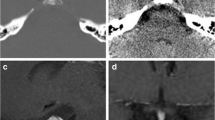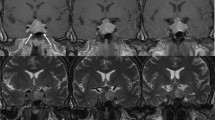Abstract
Objective
Radiological calcification in nonfunctioning pituitary adenoma is scarcely rare, which appears in various formations and raises special diagnostic and therapeutic challenges. Here we present our experience about the clinical aspects and treatment of calcified nonfunctioning pituitary adenoma.
Methods
A total of 145 patients who underwent surgical resection of nonfunctioning pituitary adenomas via endoscopic endonasal approach from February 2008 to December 2018 were reviewed. Among these patients, cases with radiological calcifications on preoperative imaging were included in this study. We analyzed these patients’ records, radiological neuroimaging, endocrine evaluation, operative notes as well as intraoperative videos.
Results
Calcification on preoperative neuroimaging was observed in only 7 patients with nonfunctioning pituitary adenomas. The study population consisted of these seven patients with intra-tumor calcification (n = 2), thin and egg shelf-like capsular calcification (n = 3), hard and armor-like capsular calcification (n = 2). In 85.7% of cases (n = 6), nonfunctioning pituitary adenomas with calcification were characterized by soft tumor texture. Evidences demonstrated apoplexy occurred in 71.4% of cases with calcified pituitary adenomas (n = 5). Patients with intra-tumor calcification as well as with thin and egg shelf-like capsular calcification underwent resection of both tumor and calcification through extra-pseduocapusual dissection via endoscopic endonasal approach. Besides, in the remaining 2 cases (28.6%), hard and armor-like capsular calcification was found surrounding a soft tumor component; however, it did not interfere with adequate removal of the soft part via endoscopic endonasal approach with the hard calcification untouched. Postoperative course of all patients was uneventful. Long term follow-up (median interval of 49 months, range 8–70 months) showed that no recurrence occurred.
Conclusions
Although relatively rare, calcified nonfunctioning pituitary adenoma should be kept in mind to avoid making a wrong preoperative diagnosis. Given various calcification types, multiple surgical tactics is required accordingly. Extra-pseudocapusual resection via endoscopic endonasal approach is helpful for the resection of both adenoma and calcification.



Similar content being viewed by others
References
Gezercan Y, Acik V, Çavuş G, Ökten AI, Bilgin E, Millet H et al (2016) Six different extremely calcified lesions of the brain: brain stones. Springerplus 5(1):1941
Müller HL (2014) Craniopharyngioma. Endocr Rev 35(3):513–543
Kato T, Kuwayama A, Takahashi T, Kageyama N (1983) Calcification in pituitary adenomas. Neurol Med Chir (Tokyo) 23:633–637
Ogiwara T, Nagm A, Yamamoto Y, Hasegawa T, Nishikawa A, Hongo K (2017) Clinical characteristics of pituitary adenomas with radiological calcification. Acta Neurochir (Wien) 159(11):2187–2192
Rasmussen C, Larsson SG, Bergh T (1990) The occurrence of macroscopical pituitary calcifications in prolactinomas. Neuroradiology 31:507–511
Chentli F, Safer-Tabi A (2015) Pituitary stone or calcified pituitary tumor? Three cases and literature review. Int J Endocrinol Metab 13(3):e28383. https://doi.org/10.5812/ijem.28383v2
Gang MK, Singh G, Brar KS, Kharb S (2013) Pituitary calcification masquerading as pituitary apoplexy. Indian J Endocrinol Metab. 17(Suppl 3):S703–S705
Landolt AM, Rothenbühler V (1977) Pituitary adenoma calcification. Arch Pathol Lab Med 101(1):22–27
Murase M, Toda M, Kentarou O, Ishihara E, Yoshida K (2019) Endoscopic endonasal removal of large calcified pituitary adenoma: case report and review of the literature. World Neurosurg. https://doi.org/10.1016/j.wneu.2018.11.255
Taylor DG, Jane JA, Oldfield EH (2018) Resection of pituitary macroadenomas via the pseudocapsule along the posterior tumor margin: a cohort study and technical note. J Neurosurg 128(2):422–428
Glezer A, Bronstein MD (2015) Pituitary apoplexy: pathophysiology, diagnosis and management. Arch Endocrinol Metab. 59(3):259–264
Thotakura AK, Patibandla MR, Panigrahi MK, Addagada GC (2017) Predictors of visual outcome with transsphenoidal excision of pituitary adenomas having suprasellar extension: a prospective series of 100 cases and brief review of the literature. Asian J Neurosurg. 12(1):1–5
Chambers AA, Lukin R, Tsunekawa N (1976) Calcification in a chromophobe adenoma. Case report. J Neurosurg 44:623–625
Keene M (1979) Pituitary calcospherites: an aid to highly selective hypophysectomy. J Laryngol Otol 93:613–616
Rilliet B, Mohr G, Robert F, Hardy J (1981) Calcifications in pituitary adenomas. Surg Neurol 15:249–255
Kertmen H, Turkoglu E, Baskaya MK (2010) A calcified sellar lesion. J Clin Neurosci 17(7):897–956
Horiuchi T, Tanaka Y, Kobayashi S, Yokoh A, Unoki T (1996) Total capsular calcification in a prolactinoma -case report. Neurol Med Chir (Tokyo). 36:729–732
Ibrahim R, Kalhan A, Lammie A, Kotonya C, Nannapanenni R, Rees A (2014) Dense calcification in a GH-secreting pituitary macroadenoma. Endocrinol Diabetes Metab Case Rep. 2014:130079. https://doi.org/10.1530/EDM-13-0079
Tamaki T, Takumi I, Kitamura T, Osamura RY, Teramoto A (2000) Pituitary stone—case report. NeurolMed Chir (Tokyo). 40:383–386
Celzo FG, Venstermans C, De Belder F, Van Goethem J, van den Hauwe L, van der Zijden T et al (2013) Brain stones revisited-between a rock and a hard place. Insights Imaging 4:625–635
Rilliet B, Mohr G, Robert F, Hardy J (1981) Calcifications in pituitary adenomas. Surg Neurol 15:249–255
Tanrivor N, Kucukyuruk B, Hatipoglu E, Comunoglu N (2014) Pituitary stone: a case report and review of the literature. Turk Neurosurg. 24(6):967–973
Penn David L, Burke William T, Laws Edward R (2018) Management of non-functioning pituitary adenomas: surgery. Pituitary. 21:145–153
Monteith SJ, Starke RM, Jane JA Jr, Oldfield EH (2012) Use of the histological pseudocapsule in surgery for Cushing disease:rapid postoperative cortisol decline predicting complete tumor resection. J Neurosurg 116:721–727
Qu X, Xu G, Qu Y, Song T (2011) The pseudocapsule surrounding a pituitary adenoma and its clinical significance. J Neurooncol 101:171–178
Acknowledgements
The authors gratefully acknowledge Mrs. Hu Ai ying for the revision of the manuscript.
Author information
Authors and Affiliations
Corresponding author
Ethics declarations
Conflict of interest
The authors declare there is no conflict of interest that would prejudice the impartiality of this scientific work.
Additional information
Publisher's Note
Springer Nature remains neutral with regard to jurisdictional claims in published maps and institutional affiliations.
Rights and permissions
About this article
Cite this article
Xie, Z., Wang, Q. & Lu, X. Endoscopic endonasal resection of nonfunctioning pituitary adenoma with radiological calcification. Pituitary 22, 381–386 (2019). https://doi.org/10.1007/s11102-019-00967-7
Published:
Issue Date:
DOI: https://doi.org/10.1007/s11102-019-00967-7




